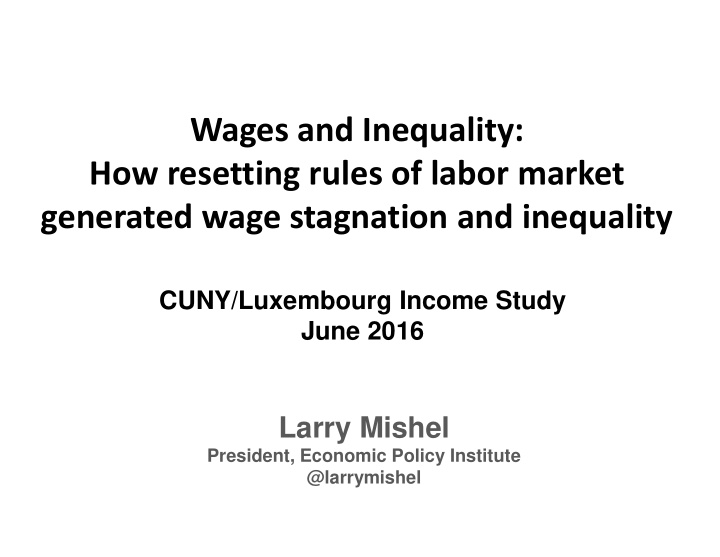



June 2015 Wages and Inequality: How resetting rules of labor market generated wage stagnation and inequality CUNY/Luxembourg Income Study June 2016 Larry Mishel President, Economic Policy Institute @larrymishel
The basic facts The Wage Patterns to be Explained
Wage Gaps 1. Top 1% vs. top; 2. Top vs. middle; and 3. Middle vs. bottom
www.epi.org 5
www.epi.org 6
www.epi.org 7
www.epi.org 8
www.epi.org 9
Decomposing Productivity-Median Hourly Compensation Gap
The Productivity-Pay Gap 1. Stagnant Compensation (wages & benefits) stagnation not due to failure of economy to expand productivity. There was lots of income and wealth produced. 2. Gap primarily due to rising inequality, especially in 2000s: a. Inequality of compensation b. Decline of labor’s share
The Cause? Conventional Wisdom says: 1.Globalization; 2. Technology/Skills Deficits; 3. and ?????
Summers on SBTC “And I am concerned that if we allow the idea to take hold that all we need to do is there are all these jobs with skills and if we just can train people a bit then they will be able to get into them and the whole problem will go away. I think that is fundamentally an evasion of a profound social challenge .”
Why the ‘Skills Deficit’ Explanation Fails 1. The 2000’s Do Not Fit the Stories 2. The Slowdown in Relative Demand for ‘Skill’/Education
Two Stories 1. Education —need for college graduates— driven by technology/computers 2. Occupations —job polarization computers erode middle , expand relative demand for non-routine, cognitive skills expands at top and do not affect routine, manual work at bottom
September 2012 www.epi.org 16
Marxist Explanation ‘ Are you going to believe me, or what you see with your own eyes?’ Groucho Marx Examples: unpaid internships, stagnant college wages, especially young, and underemployment
www.epi.org 18
What about Occupations? 1. No evidence of job polarization in 2000s 2. Slowdown in relative demand started in mid-90s
20 Changes in Changes in Changes in occupation overall wage occupation Technology employment distribution wages shares
21
Missing Pieces Policy choices, on behalf of those with most wealth and power, that have undercut wage growth of a typical worker: 1. Excessive unemployment; 2. Weakened labor standards; 3. Eroded institutions: collective bargaining 4. Top 1.0% wage/income growth
Context • Vast majority live paycheck to paycheck • Little or no wealth • No staying power • Safety net eroded
Drivers of Top 1% Incomes • Executives, escalating pay • Financial sector, larger and better paid • Lower marginal income tax rates
www.epi.org 26
27 www.epi.org
28 www.epi.org
29 www.epi.org
Macroeconomic Failure • Excessively high unemployment, 1979-2015 • Depresses wage growth, drives up wage inequality
www.epi.org 31
Labor Standards Weakened 1. Minimum wage 2. Misclassification/wage theft/enforcement 3. Undocumented workers/guest-workers 4. Overtime 5. Franchising/subcontracting 6. Deregulation 7. Forced Arbitration of disputes
March 9, 2009 www.epi.org 33
Labor Market Institutions Weakened 1. Collective bargaining; 2. Spillover effect 3. Political voice …….Not simply endogenous
www.epi.org 35
Quantitative Change leads to Qualitative shifts These policy shifts have impacts by: 1. Spillover effects on those not directly affected, e.g., undocumented workers, lower union density; and 2. Changes Norms : revising standards in the marketplace; and 3 .Factor shares : Loss of labor’s share of income
End
Recommend
More recommend